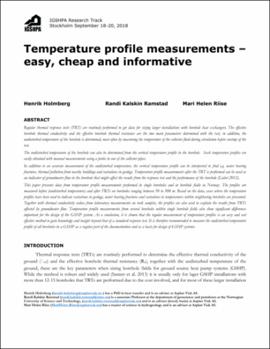| dc.contributor.author | Holmberg, Henrik | |
| dc.contributor.author | Ramstad, Randi Kalskin | |
| dc.contributor.author | Riise, Mari Helen | |
| dc.contributor.other | IGSHPA Research Track (2018) | |
| dc.date.accessioned | 2018-08-28T17:58:53Z | |
| dc.date.available | 2018-08-28T17:58:53Z | |
| dc.date.issued | 2018 | |
| dc.identifier | oksd_ighspa_2018_holmberg | |
| dc.identifier.uri | https://hdl.handle.net/11244/301565 | |
| dc.description.abstract | Regular thermal response tests (TRT) are routinely performed to get data for sizing larger installations with borehole heat exchangers. The effective borehole thermal conductivity and the effective borehole thermal resistance are the two main parameters determined with the test, in addition, the undisturbed temperature of the borehole is determined, most often by measuring the temperature of the collector fluid during circulation before startup of the test. The undisturbed temperature of the borehole can also be determined from the vertical temperature profile in the borehole. Such temperature profiles are easily obtained with manual measurements using a probe in one of the collector pipes. In addition to an accurate measurement of the undisturbed temperature, the vertical temperature profile can be interpreted to find e.g. water bearing fractures, thermal pollution from nearby buildings and variations in geology. Temperature profile measurements after the TRT is performed can be used as an indicator of groundwater flow in the borehole that might affect the results from the response test and the performance of the borehole (Liebel 2012). | |
| dc.description.abstract | This paper presents data from temperature profile measurements performed in single boreholes and in borehole fields in Norway. The profiles are measured before (undisturbed temperature) and after TRTs on boreholes ranging between 50 to 500 m. Based on the data, cases where the temperature profiles have been used to indicate variations in geology, water bearing fractures and variations in temperatures within neighboring boreholes are presented. Together with thermal conductivity values from laboratory measurements on rock samples, the profiles are also used to explain the results from TRTs affected by groundwater flow. Temperature profile measurements from several boreholes within single borehole fields also show significant differences important for the design of the GSHP system. As a conclusion, it is shown that the regular measurement of temperature profiles is an easy and cost effective method to gain knowledge and insight beyond that of a standard response test. It is therefore recommended to measure the undisturbed temperature profile of all boreholes in a GSHP as a regular part of the documentation and as a basis for design of GSHP systems. | |
| dc.format | application/pdf | |
| dc.language | en_US | |
| dc.publisher | International Ground Source Heat Pump Association | |
| dc.rights | In the Oklahoma State University Library's institutional repository this paper is made available through the open access principles and the terms of agreement/consent between the author(s) and the publisher. The permission policy on the use, reproduction or distribution of the article falls under fair use for educational, scholarship, and research purposes. Contact Digital Resources and Discovery Services at lib-dls@okstate.edu or 405-744-9161 for further information. | |
| dc.title | Temperature profile measurements - easy, cheap and informative | |
| osu.filename | oksd_ighspa_2018_holmberg.pdf | |
| dc.identifier.doi | 10.22488/okstate.18.000027 | |
| dc.type.genre | Conference proceedings | |
| dc.type.material | Text | |
